We are delighted that our vessel, the Cable Innovator, has successfully completed a cable laying project for the Neptune Observatory project in the Cascadia Basin in collaboration with Ocean Networks Canada.

To learn more about this detailed project and how it sets the Observatory up for another successful year, click here.
Click here to learn more about our Subsea Cable Installation servicesFind
We take immense pride in recognizing the outstanding achievement of our GMG rowing team members – Dave Dunk, Craig Beech and Spike Johns. They successfully conquered the challenging task of rowing 1,000,000+ metres in January as part of the wider rowing community ‘Concept2’ team challenge. Impressively ranking first on the ‘Corporate’ table when measured by average metres per rower.
The team dedicated their efforts to raising crucial funds for Children’s Cancer North
The concluding day of this challenge took place at our head office, Ocean House in Chelmsford, where they were supported by fellow rowers from across the business.
Although the challenge is complete, donations are still welcome to support Children’s Cancer North and to celebrate the remarkable achievement of our dedicated team. Contributions can be made at – https://hubs.ly/Q02jD8Hg0
Global Marine’s Specialist Interconnectivity Solutions Team is very proud to have supported a state-of-the-art cable system designed to observe abyssal areas of the Ionian Sea. The “InSEA” cable system was successfully deployed to a depth of 2,300m, 30 Km off the Sicilian coast to monitor the Adriatic and Eurasian tectonic plates. The objective is to explore the utilization of seismometers and environmental monitoring sensors strategically placed within and around the repeater enclosures of conventional telecommunications cables, ensuring that the gathered data remains both scientifically and operationally uncompromised.

The system comprises of three repurposed submarine telecommunications repeater housings fitted internally with a variety of Güralp Systems Ltd specialist seismometers and data communication equipment and connected externally to both pressure and temperature sensors mounted on the cable 30 m from the main housing.
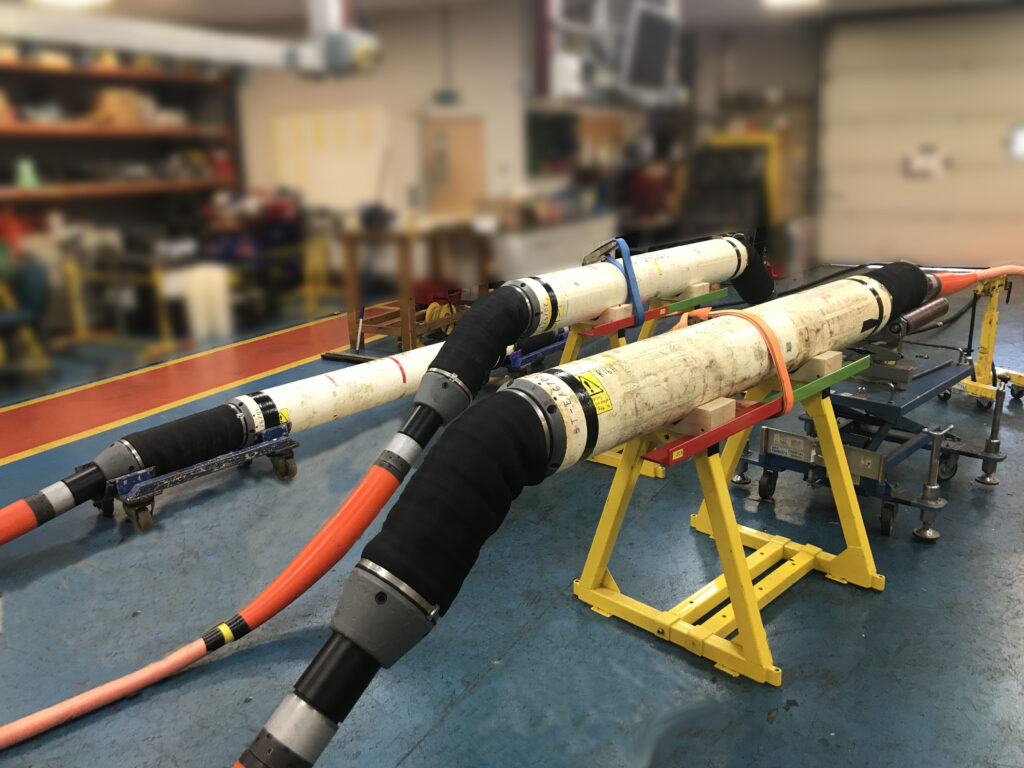
Using our specialist knowledge and experience Global Marine sustainably repurposed and retro fitted it’s bespoke composite optical/power penetrator technology into the 30-year-old Optical Amplifier Module (OAM) housings and bulkheads. Key to the success was the development and delivery of a unique external “on cable” sensor module pack solution by the Global Marine team. This provided a protective mounting and data cable interconnect to the temperature and pressure sensors remote from the main housing, negating the need to break into the underlying cable structure.
In the Global Marine Lab in Chelmsford, UK, modifications were made to original OAM terminations so that they could be interfaced with the related sensor packs using sustainably repurposed cable tails of a similar era to the housings. Once completed the units were transported to Catania for system integration on the cable vessel using Global Marine, Universal Jointing (UJ) technology prior to deployment.
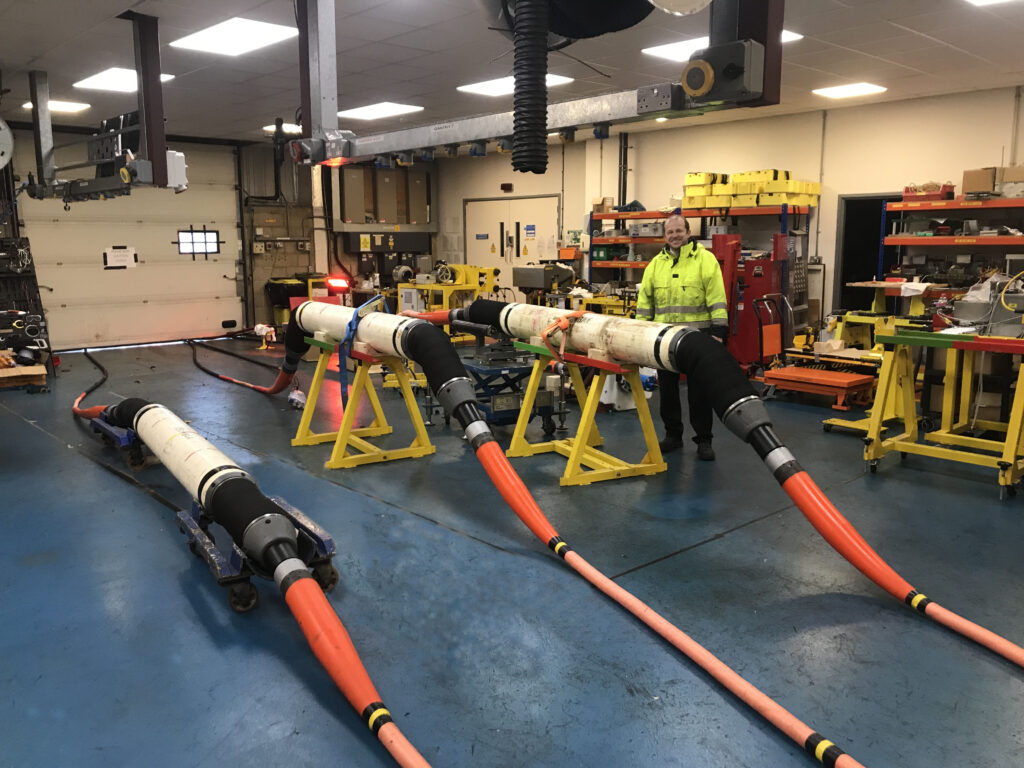
The Interconnectivity team supported Güralp in the delivery of this SMART (Science Monitoring And Reliable Telecommunications) cable system, for their customer the National Institute of Geophysics and Vulcanology of Italy (INGV).

Using standard marine installation process and techniques, the system was successfully deployed and tested on 20th December 2023 and marks a significant industry milestone through the adoption of Global Marine ’s specialist integration solutions to realise the repurposing of submarine telecoms technology to advance subsea science. Global Marine is proud to have been involved in this unique and exciting project and would like to thank Güralp for entrusting us with the responsibility and showing confidence in our role in its successful execution.
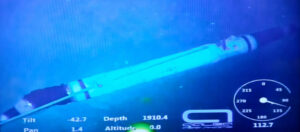
Related Links:
InSEA SMART Cable: wet demonstrator project (guralp.com)
https://www.guralp.com/about-us/news-and-events/guralp-successfully-deploys-worlds-first-smart-cable
ITU/WMO/UNESCO IOC Joint Task Force
Seafloor fibre-optic cables become sensor stations – Science Issue 6688
As trusted custodians of over 2.8 million kilometres of rich submarine cable data, OceanIQ are delighted to celebrate this landmark 25th GeoCable® anniversary.
Over 25 years the GeoCable® dataset has continuously evolved and is now accessible through our complimentary submarine cable map, or via subscription services such as GeoCable®Light or GeoCable®Pro – for customers who wish to develop cable routes in-house, analyse the data and create RPLs within GIS software packages. For more information about these product offerings click here –
https://hubs.ly/Q02b_KvQ0
To mark the 25th anniversary of GeoCable® – OceanIQ Permitting & GIS Manager – Brian Perratt reflects on the changing landscape of the subsea cable industry and the evolution of GeoCable® to meet marine stakeholder needs.
You can read Brian’s informative blog at the following link – https://hubs.ly/Q02d2Gmx0
Captain John Tollady from the Cable Retriever, shares his account of a long overdue visit to the charity.
At the end of September, six Officers and I visited the Ninos Pag Asa Centre in Olongapo. Due to an unprecedented cable repair programme and then Covid, nobody from Cable Retriever had been able to visit for over three years.
Cely and her team welcomed us into the Centre and we were placed at pride of place, behind a table in their main room. The children then put on a show for us. There was a mixture of song and dance.
Janvee was a small boy the last time I visited in 2014. He is now a first-year student at Gordon College. He moved between drums, bass guitar, electric piano and singing with ease. He is totally blind.
Joenard took his turn playing electric piano and belting out some beautiful ballads, a particular favourite in the Philippines. His voice was amazing. He too is totally blind, but that didn’t seem to trouble him one bit, as he played the keys and adjusted the various dials with aplomb. He is the one who gives the blind children at the orphanage music lessons.
Patricia has a beautiful smile and great voice. She stood in the middle of the room and sang wonderfully. Her eyes are white. She doesn’t have pupils or irises, like you or I. She is at Grade 11 at school. One of the deaf children walked with her to the place where she was to perform and then brought her back to her seat after her songs.
A lot of the children work in twos. The deaf seeing for the blind and the blind hearing for the deaf. Cely explained that as there were not only children and staff attending that day, but also various parents of children who are undergoing cleft palate operations, the Centre was unusually busy and this made it more difficult for the blind children. On less busy days, they are fine making their own way around the Centre, up and down stairs unaided. They have the same chores in the kitchen as the sighted children and need no assistance with almost every facet of life. It is just in the outside world where the dangers lie. Pavements, guide dogs, pelican crossings and the bobbly tiles on our pavements, that indicate the sloped approach of a road crossing, are just not part of where they live.
Cely called a lovely little girl over, Cely said that she was 12. Her name is Baby Girl and she is deaf. Cely explained that she had been abandoned in a Mall, presumably by her parents, with a small plastic shopping bag her only possession. The Mall security found her late in the evening, wandering alone. She was taken to a shelter. Cely took her in and that day became her birthday, she knew no other. Everybody called her Baby Girl and that is all she has ever been called. Broadcasts on local radio, photos in local papers and posters on lamp posts for miles around produced nobody that knew (or wanted to admit) to knowing who she was. After three months Cely took her to the dentist to establish a medical base level and for him to advise how old the girl most probably was, by aging her teeth. He said three. So, nine years ago, three year old Baby Girl became one of the children we all sponsor. She will hopefully work through the mental scars of being abandoned by her parents and with our help, go to college, get a job and have a ‘normal’ life.
Several of the children I met in 2014 have married and are starting families of their own now. Cely said that they all visit and help when they can.
Shelwin is a third year college student’ reading Criminology. Ronnel is a first year student as St. Joseph College.
Angelica and Samantha are fourth year students doing a BSed. They graduate next July. Mariele and Kenna are second year students taking Psychology at Aura College.

None of these young people would have had these opportunities without Global Marine Group’s support. Their success in education not only gives them a life but inspires the others still in the Centre, that they too can achieve success when they grow up. There is a future.
I think that Cely said that there are 32 children in the Orphanage at present. Back when I visited in 2014, I was struck by how hopeless it all seemed. The poor little kids had most often been abandoned by parents who could not look after a child with disabilities. At least with Cely and the Centre they were safe, but I wondered ‘and then what?’. It seems that whilst I was right about how hard their lives were, there have been so many great success stories. Children Global Marine Group have sponsored have attended college and now have good jobs. Many of them came to our visit on Tuesday, to express their gratitude for the chance we have given them. It is very humbling to sit there and listen to a procession of young people thank you for the support and chance we have given them to be something other than abandoned children.
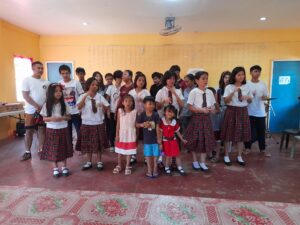
We had brought Pizza and Coke and it became a scene I have witnessed before in that same room. Just kids eating a lunchtime meal and talking, signing and giggling together. It felt ‘normal’ (that word again) and some of the feelings of guilt, from having so much while they have so little, subsided. If not for the dishevelled surroundings and a general lack of uniform, it could have been any number of after school events I have attended, when my own children were in school.
Children kept on coming up to shake our hands and put the back of our hands against their forehead, as a sign of respect. All the “thank you’s” were followed by “Po”, which is a Tagalog expression of respect. These poor little things haven’t a real clue who you are or why you are there, but they know that you are something good in their life and are on their side. They must spend many hours wondering what will become of them and what their futures hold. That is why I was so glad to see older children and even adults who have gone on, with Global Marine Group’s assistance, to have full and meaningful lives. It gives the little ones hope.
I think that Cely said that we have sponsored over 70 cleft palate operations this year, with another 20 planned. This is something that I have rarely seen in Europe. A baby is born with a deformation of the palate/top lip and if nothing is done, that child will have a disfigured face all their life. We are a judgemental species and with such an obvious deformity, they suffer taunting and discrimination. It is a surprisingly easy, quick and successful procedure, sometimes needing a second operation. The result is transformative. What was once the defining feature of a person’s face, becomes a faint scar line. You wouldn’t really notice. The operations we pay for make a real difference to a lot of people’s lives out here.
Global Marine Group is currently sponsoring the building of an extra room in the Centre. It will become sleeping quarters for maybe 6 girls, with an integral bathroom.
As with UK charities or even the NHS, need seems to grow to match the funds available. Rice is a lot more expensive since Covid. Everything seems to cost more. Something those of us who live in the UK can relate to. It is just that the Centre is starting at a much lower level.
The boys’ dormitory was stifling. The two ceiling fans had motors, but no blades. Of course, air conditioning is not an option. The ship will see if we can supply some fans, to at least move the hot air around.
Before we left, two boys came over to us. The taller, older one, leading the other, tiny boy. The little boy had the same white eyes that the girl who sang for us a couple of hours earlier had. A difference was that his right eye did have a pupil in one eye. Cely said that he has been for tests and they await the results to see if he can be operated on, to give him some sight in his right eye. She said that they had a similar case a couple of years ago and the surgeons managed to save an eye and that child therefore can see and has moved on. Global Marine Group money did that. A little boy now has a life that he would not otherwise have had, due to the contributions we make. The little boy who stood next to me is too young to understand, but we do.
As we were driven away from the Centre, I again experienced the disbelieving words from the other guys in the car that I had heard nine years before, as to what they had seen. Such hardship and misfortune, but also such love and hope. It really is a very special place. Heart breaking, but also filling you with pride for what Global Marine Group does and that there are such good people around as Cely and her team, who do what we cannot or choose not to do, to help children.
About the Ninos Pag Asa Centre
The Centre provides much needed care and support and those who are not cared for or looked after by any other agency in the Philippines. It is authorised and licensed to operate as a social work agency giving medical assistance, educational programmes, skills training and community-based rehabilitation. The centre not only look after those who are resident, but also educate and assist other children and adults in the local community.
Global Marine Group has been supporting the centre since our vessel the Cable Retriever arrived nearby in 1998 to support the SEAIOCMA region with cable maintenance and repairs. The Captain of the Cable Retriever, together with Richard McFarlane in the Philippines depot, and colleagues in the UK take responsibility for supporting the centre and organise many activities to this end throughout the year. For more information about how we support the centre click here.
One of the oldest and most well-known maritime superstitions was that bringing women aboard a vessel was bad luck. Fortunately all that has now changed, and we’re firm believers in supporting growing diversity across our workforce across the globe.
We spoke to one of our Chief Officers, Kaya Teare, about life offshore as a woman, playing a critical role onboard a submarine cable ship.
Kaya is one of our fantastic crew members, currently serving onboard the C.S. Sovereign in Portland, England. She has eight years of qualified experience on cable repair and maintenance vessels with Global Marine. She has previously served as a Third Officer, Second Officer, and Deputy Offshore Installation Manager (DOIM) and plans to obtain her master’s ticket in 2024.
After completing her honors degree in navigation and maritime science, Kaya Teare took to the seas to work on cable repair and installation vessels. Having moved up the ranks from Deck Cadet to Chief Office, she is a strong advocate for reducing the gender gap and including women in all teams and departments, especially at senior levels.
I have always lived by the sea and near ports. I was born in Osaka, Japan, a major port, and grew up in Peel, Isle of Man, a fishing town. I enjoyed kayaking, camping, and sailing as a teenager and was looking for my next adventure. When I was 18, I was ready to leave the island, travel, and live independently. I initially thought I would take a year out to travel and work as a stewardess on a superyacht. My friends and family asked me why I wanted to be a stewardess, and I quickly realised I didn’t.
I started researching jobs at sea / cadetships and decided I wanted to be a deck officer. I liked the sound of a course that would have a year in industry, learning how to navigate, being sponsored, and coming out with a professional qualification to start my career. When I was applying for sponsorship, I wanted to work on cable ships because they sail worldwide, have many personnel onboard, and don’t complete routine passages.
I don’t come from a family of mariners and didn’t know anyone working at sea before I started. I didn’t consider that I would be the only women in lectures / courses or onboard the vessels. I was always surprised and wondered why more women didn’t want to do this as a career. With hindsight, I don’t think women fear taking it up as a profession: I think they don’t consider it an option. I was lucky enough to have people around me that questioned me and helped me realize that there are more opportunities for women at sea
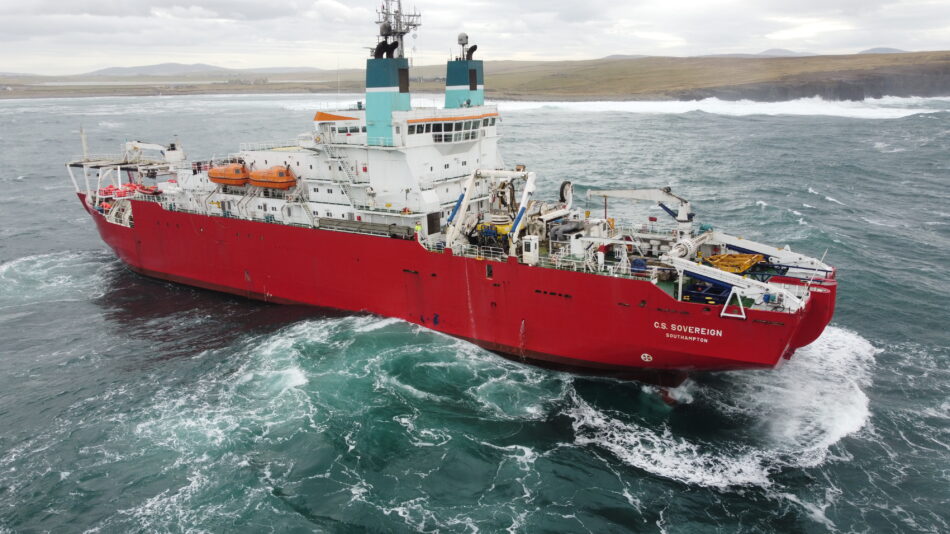
I grew up with two different cultures, as I am half Japanese and half Manx. I have always enjoyed working with people of different cultures and backgrounds. It is interesting to see how different cultures range in their working methods and how they approach situations. I see it as an opportunity to learn and see something from a different perspective. I never expect to be accepted and respect others people’s views. I think simply by being there and doing what I do, it will show people who have never seen women working at sea before that it is possible. I think this is the best way of showcasing what women at sea can do.
I have seen many positive changes in the industry, especially in the last three years. I now regularly sail with other women, whereas in the past, I was mostly the only woman onboard. Also in recent years, personnel with strong traditional opinions have retired and more personnel accepting of all genders are onboard cable ships.
I genuinely feel the company and my colleagues have given me equal opportunity and fully supported me. There are, of course, some characters who are not as accepting, but I have found over time they adjust to the change that they are not used to seeing. I believe over time being a woman at sea will not be a novelty. There is room for more women to work at sea, and they should feel we
Our Head of Asia, Sheryl Ong, is going to be presenting at the SubOptic Foundation Symposium in Singapore in just a couple of weeks time.
It’s a great chance for professionals and undergraduates to get an exciting insight into the world of subsea cables and the potential careers available within the sector.
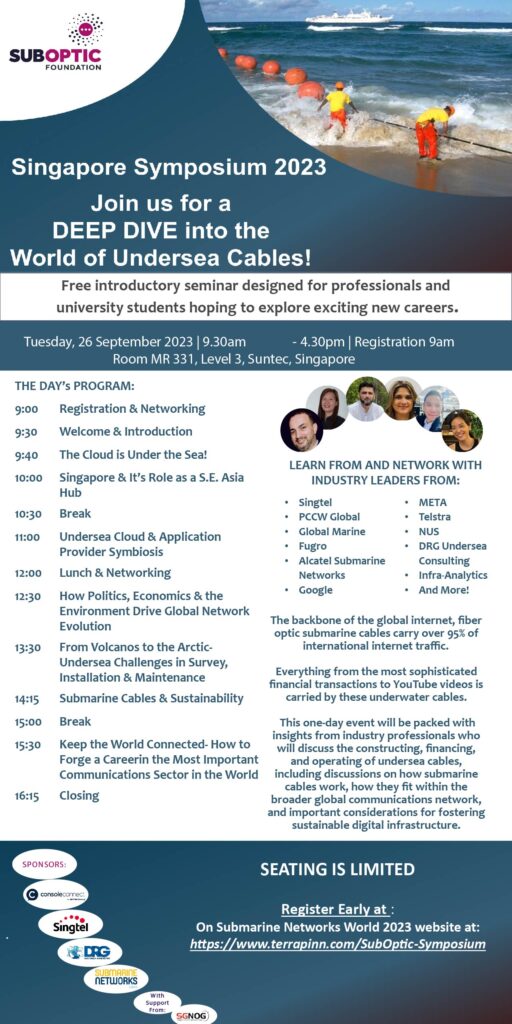
There’s still time to register to attend for free here: SubOptic Symposium (terrapinn.com)
Our Permitting & GIS Manager Brian Perratt, recently had an article published in PES Wind magazine. You can read the article as printed in the publication here, or carry on to read in full below.
Submarine telecoms cables have an average of 210 faults per year on the global infrastructure, the vast majority of which are caused by external aggression such as fishing and anchoring.
Many of the increasing network of power interconnector, array and export cables follow similar routes or are in similar areas as the shallower water telecoms cables. We can therefore be reasonably confident that the same threats that cause outages on telecoms cables have the potential to have the same impact on power cables. With cable damage accounting for as much as 80% of insurance claims for offshore wind farms and individual cases known to have caused losses of £10 million when lost output and repair costs are combined, it’s an issue that can’t be overlooked.
Most offshore renewables export cables and power interconnector cables have been installed in the last 15 years or so, conversely fibre optic telecoms cables have been in use since 1986. This, coupled with the relatively low number of power cables in comparison to telecoms, means that we have a lot less data and insights around their fault rates, causes and predictions since there are far fewer power cable faults over a smaller area to analyse. In the waters around the North Sea, English Channel and Irish Sea for example, there have been over 900 telecoms cable faults in the last 35 years but only approximately 70 power cable faults recorded over the same area since the year 2000.
The causes of cable outages on both telecoms and power cables are similar. However, the numbers attributed to each cause are substantially different.
According to a recent study carried out by ORE Catapult only 8% of power cable outages were as a result of third party external damage. All other outages occurred as a result of the installation process or from a manufacturing issue. Conversely, telecoms cable outages are predominantly caused by third party damage with only 5% being attributed to installation or manufacturing issues.
The number of manufacturing and installation outages on power cables are likely to reduce in future due to improved installation methodologies and cable design. However, as more kilometres of power cable is installed the number of third party outages is likely to increase. Cable awareness campaigns and AIS vessel monitoring may help to negate this, however, it would be naive to think that external damage will ever be completely eradicated. Therefore, any measures we can take to help ensure cable integrity should be welcomed. This is where the analysis of historical telecoms outages can help.
Historical data can provide a detailed understanding of what areas are more prone to damage from third party aggression. This can be further broken down to detail what the causes of faults have been and are therefore likely to be in the future.
Third party damage is predominantly caused by fishing and anchoring for both telecoms and power cables. Figure 1 shows a breakdown of the causes of faults worldwide on the telecoms cable network from 1986 to present day

By analysing the what, where, when and why for all of these faults a meaningful fault rate heat map and prediction model has been created. Areas of high fault rates and their causes can be identified, and the fault rate prediction model provides an educated calculation as to the likely number of faults for new cable systems. This analysis is for telecoms cables, however we can start to apply the same principles to power cables by using this information along with a more targeted in depth study of the expected burial depth of the power cable versus the burial depths of the telecoms cables.
The Fault rate heat maps use a grid cell structure to ensure cable anonymity. By cross referencing the cable lengths and number of faults (telecoms) that have occurred in each grid cell an expected number of faults per kilometre of cable per year can be calculated. Figure 2 shows an example fault map for all fault causes. The green areas have experienced no faults, yellow low fault rate through to red, high fault rate. Figure 3 shows the same area for fishing faults and Figure 4 for faults caused by anchors.
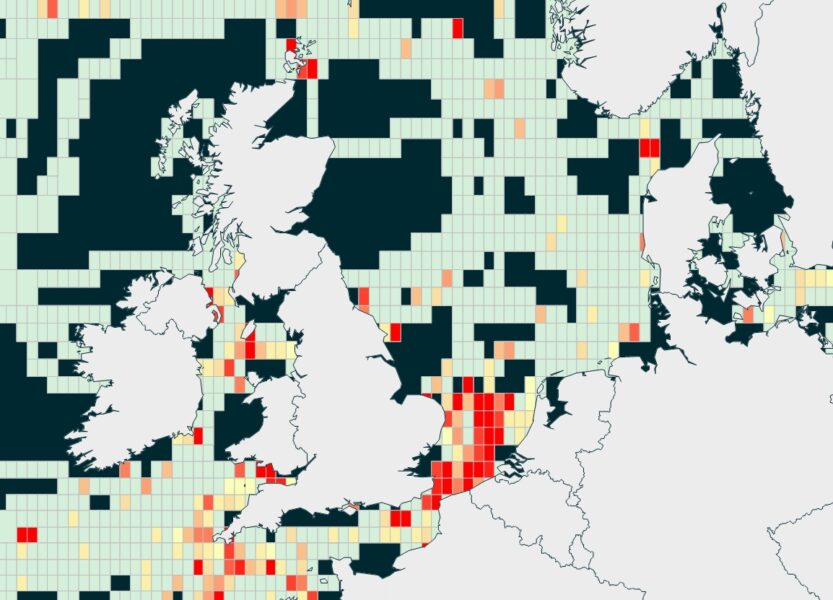
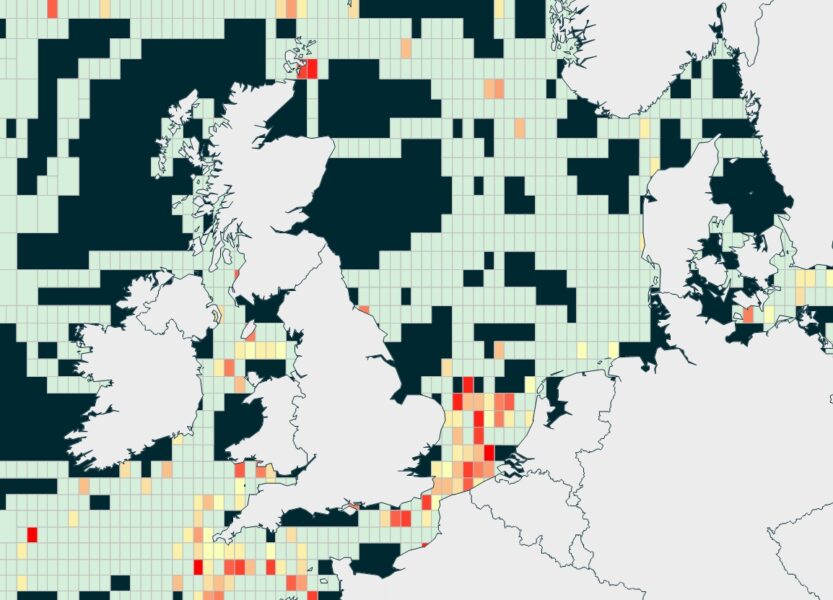
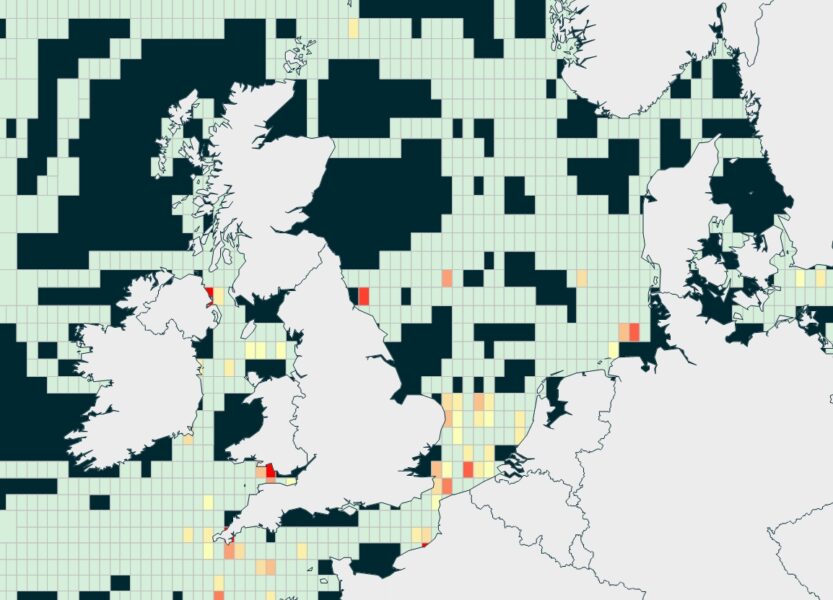
By using the heat map data layers a fault rate prediction report can be created. This allows for the prediction of how many, where and why faults are likely to occur on newly installed or planned cables, all based on actual historical fault occurrences.
Figure 5 is an example of a fault prediction map for a fictional cable system crossing the North Sea. Again, green areas are no expected faults, yellow low, and red high fault rates. The report also gives a breakdown of the likely causes of faults along with which country’s maritime waters they will be in, figures 6 and 7
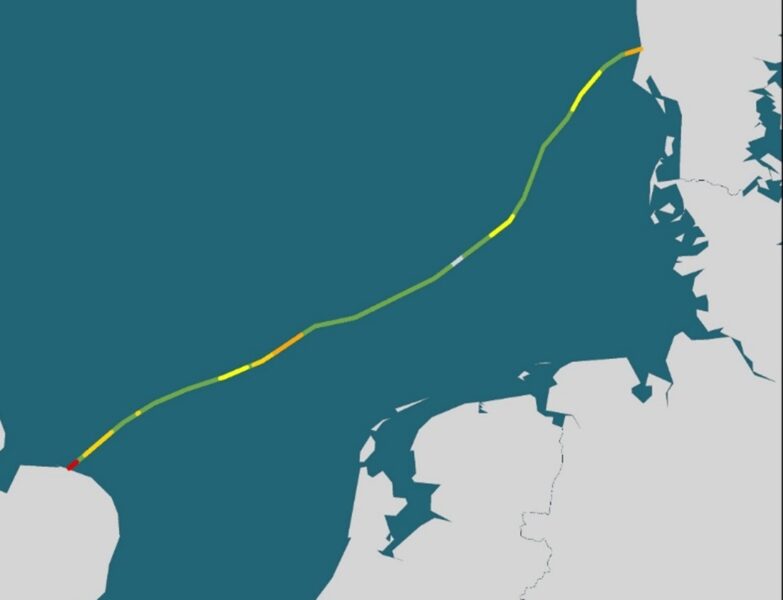
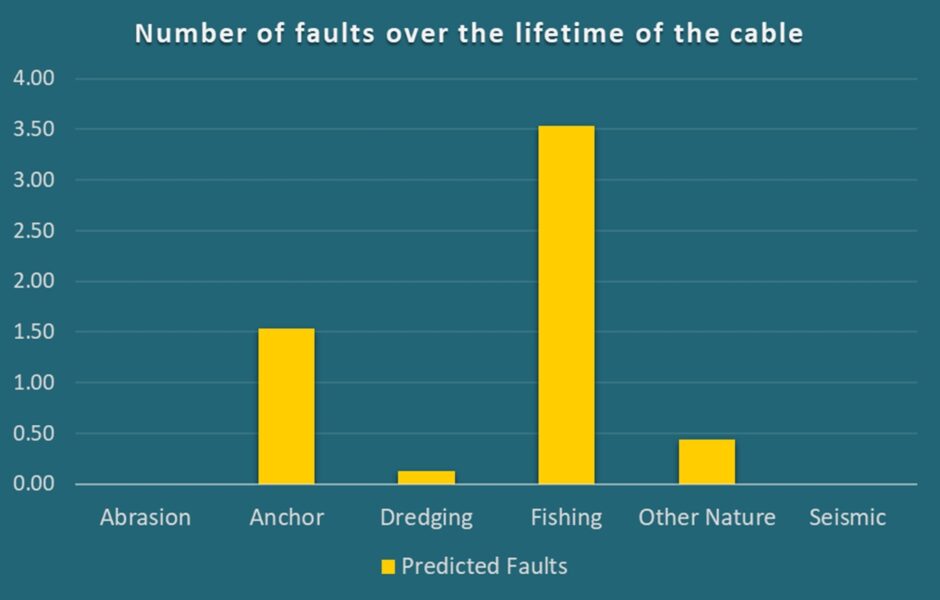

As can be seen, by reviewing the historical telecoms data we can get a good understanding of the number and causes of faults that may affect power cables and as a result modify the approach to their planning, installation and maintenance to reflect that intelligence. Be it altering the routing to avoid fault hotspots, utilising different cable protection techniques or considering installation methodologies in more detail – addressing the factors that are potentially fixable and more within our control.
The cable fault heat maps and prediction model for telecoms cable provides an in depth understanding of the likely causes and number of faults. If we have data covering areas where power cables are being installed then we can utilise the same data to give an understanding of the external threats likely to cause problems to power cables. However, there are differences that need to be taken into account that prevent a direct crossover to power cable fault analysis.
Power cables often have slightly deeper burial and installation techniques can also differ. Power cables tend to be trenched whereas telecoms are more often ploughed into the seabed. Pre-sweeping of sand waves where the top of the sand wave is removed prior to installation of the cable, is more likely to occur for power cables and is very rare for telecoms cables.
Historically telecoms cables have had a target burial depth of 1m. In some locations this is increased to 1.5 or 2m where there is a greater risk of cable damage. This is a target burial depth and the actual depth achieved is often slightly less.
The target burial depth for power cables is similar, burial depths achieved are often slightly deeper than telecoms though and are often dictated by regulatory and environmental conditions. 2-3 m burial depths for some areas are often dictated by legislation.
More work is being done to understand the differences in fault rates versus burial depth which will give us a better understanding of the impact of deeper burial on the number of outages caused by external factors.
Power cable damage resulting in outages has a huge economic impact. Some parts of the world are reliant on a single source of power coming into their country or location and with rerouting not an easy option, a subsea cable fault can leave thousands of homes and businesses literally in the dark. Other cables transporting energy from its source – perhaps at an offshore wind farm – back into the grid are critical, not only for the consumers of that energy, but also for the businesses running those wind farms whose losses from cable downtime can be in the millions of dollars.
Repair campaigns are not only costly, but can often take months to organise thanks to the demand for and availability of suitable vessels, personnel and other resources, as well as ensuring the planning, permits and consents are in place for any offshore operations. This is particularly important to consider in the shallower, congested areas of the seabed such as in and around offshore wind farms, where there are multiple parties using the same real estate.
Because of this, preventing faults from occurring in the first place will always be a better strategy than simply reacting to the damage as and when it happens.

We have a robust set of data for telecoms cables that allow us to make an educated assessment of the likely number of faults that a cable will experience over its lifetime. The large amount of historical data coupled with the extensive cable footprint has facilitated this. The same level of data is not available for power cables. With the similarities in location of power and telecoms cables and similar burial depths it is reasonable to assume that the external factors causing telecoms cable outages have the very real potential to cause power cable outages also.
There are obvious differences between the two cable types, however, by doing further analysis on these differences we can be more focused on the threats to power cables. Understanding these threats will allow engineers to plan for them, either through route changes, deeper burial and additional cable protection such as rock placement and mattressing. Cable awareness campaigns can be put in place to target other seabed users and ensure they are fully aware of the cable location, prevention being better than the cure.
More work is being done by the team at OceanIQ to fully understand how best to translate the data from the telecoms industry to the power cable industry. The aim is to create a meaningful set of analytical tools that will provide another weapon in our armoury to help protect the critical power cable infrastructure that we all rely on in our daily lives, making the ‘unknowns’ a little more known, and enabling cable owners to make smart, informed decisions about their assets for their long-term security and integrity.
Chelmsford, 8 March 2023. Global Marine, a market leader in subsea fibre optic cable installation including cable data and route engineering as well as cable maintenance and Universal Joint technology, has marked the delivery of its 80th ‘DXr1’ digital X-Ray camera to the market.
When introduced a decade ago, the DXr1 camera, used to inspect the integrity of submarine cable joints following jointing and repair operations, eliminated the need for film technology. This had immediate environmental and operational cost saving benefits, with film plates and chemicals no longer being shipped across the world or disposed of and is just one of the small ways in which Global Marine is looking at more sustainable operations.
The digital radiograph images produced by the DXr1 are available instantly allowing assessment to commence right away, in more detail than before and from anywhere in the world, saving around 75% in time spent compared to the more traditional film methods. In an industry where project delays can cost tens of thousands of dollars per day as vessels remain on standby for extended periods, time savings like this are crucial. The evaluation record and original images, retained electronically, negate the need for archiving and preservation of film plates.
Bruce Neilson-Watts, CEO of Global Marine Group said, “We’re proud that our digital X-Ray camera continues to be at the forefront of technology supporting the maintenance of the world’s critical telecommunications infrastructure. In the 10 years since we developed the camera, we have supplied 80 of these to customers around the world. And there’s no greater endorsement than our customers, the key players in the telecom industry, continuing to return time and again to supply multiple vessels in their fleet with our technology.”



The 80th unit was delivered to a cable installation vessel currently installing a trans-Pacific system, and has already completed joint X-Rays on its first project. Global Marine have an additional five DXr1 cameras on order, for delivery to customers early in 2023.
From today, OceanIQ – part of the Global Marine Group, a leading provider of fibre optic cable installation, repair, and subsea cable consultancy services to the telecommunications, utilities, offshore renewables and oil & gas markets – launches a series of new products, making its unrivalled database of submarine cable data even more accessible. With records stretching back over 170 years and detailed knowledge of 97% of all the world’s fibre optic cables, coupled with an extensive understanding of power cables, OceanIQ is one of the world’s leading sources of expert information and data on undersea cables.
Responding to market demand, the company has simplified access to its authoritative GeoCable data, and now offers two levels of subscription services, GeoCableLight and GeoCablePro.
GeoCableLight is a secure, web-based platform that allows a wider group of individuals to have view-access to the company’s extensive data set. This provides access to the company’s industry-leading data set beyond its traditional GIS and route engineering users. GeoCableLight is also available on mobile devices and tablets anywhere with internet access – a facility which again changes how easily the data can be accessed and digested.
For professional users who need access to OceanIQ’s full data set there’s GeoCablePro. It’s the new name for the company’s fully flexible, professional option, which has been long trusted by enterprises, governments, and multi-national bodies needing highly accurate data and cable locations and wanting to undertake complex analysis and data planning themselves.
Both GeoCableLight and GeoCablePro are subscription-based, with information that is regularly up-dated – giving users the added peace of mind that their investment as subscribers will always give them up-to-date data and information.
On the same day as OceanIQ launches its new GeoCable subscription offers, it unveils a new, free insight map of the world’s submarine cable networks – www.oceaniq.co.uk/submarinecablemap – which allows users to zoom in and out of the positions of over 1.5 million kilometres of in-service fibre optic cables, an intricate network that spans the floor of the world’s oceans, and make the modern, interconnected world possible.
This new map, OceanIQ believes, is the most accurate undersea cable map currently available online for free. Its generalised data goes way beyond other more illustrative offerings and shares just some of the unrivalled knowledge built up by the OceanIQ team over decades.
The submarine cable map is a chance for a general audience to get a taster of OceanIQ’s unparalleled knowledge, and will be of particular interest to researchers, libraries, and educational institutions, as well as anyone curious in seeing how the modern interconnected world is connected by otherwise unseen cables.
Please note: GeoCable is a registered trade name and protected by law